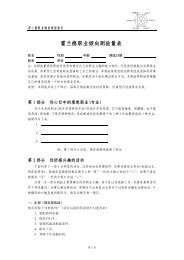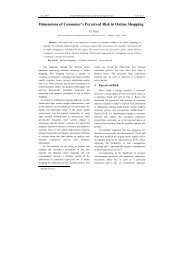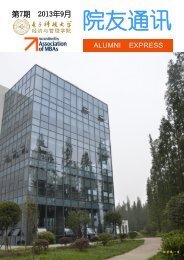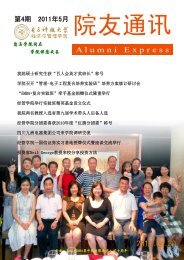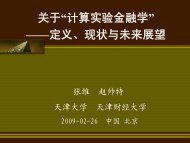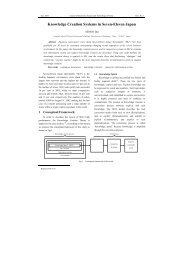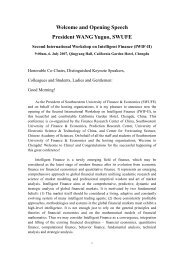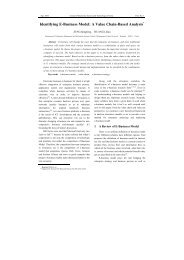from word document
from word document
from word document
You also want an ePaper? Increase the reach of your titles
YUMPU automatically turns print PDFs into web optimized ePapers that Google loves.
48Journal of Electronic Science and Technology of China Vol.2economics point of view, we will find that beyond thetechnical definition of OSS it is a public good whosevalue could be fully transferred.2.1 The Property of Public GoodThe software industry has two main significantproperties. First, the software industry is experiencinghuge economies of scale in that the development of thesoftware requires a large amount of investment, andthe cost of producing each additional copy will bealmost zero [1] . Second, the network effect, whichmeans that the benefit one consumer derives <strong>from</strong>using a product increases with the number of otherconsumers of the same product, is pervasive in thesoftware industry.Combined with the general properties of thesoftware market, the unique characteristics of the OSSwould contribute to its features of public good. As isdefined by economists, a public good is a resource thatis both non-rivalrous and non-excludable. It isnon-rivalrous if one person’s consumption of theresource does not reduce the amount available toothers. It is non-excludable if there is no feasible wayto block somebody <strong>from</strong> consuming the resource.On one hand, thanks to the economies of scale inproduction and the emergence of powerful networks,software can be copied and distributed at almost nocost. Thus the ordinary software fulfills the feature ofnon-rivalrous to some extent. On the other hand, due tothe prevalent phenomenon of piracy software, so far inChina the exclusion of people to use the proprietarysoftware freely seems very hard. The pervasive illegaldistributions for licensed software are due to thenon-excludable property of software to some extent.Furthermore, for the OSS, the fact that theinformation about how a program works, that is how itachieves its functionality, is contained within its sourcecode contributes to its non-rivalrous feature. One’sconsumption of that knowledge would leave as muchfor others as before. At the same time, it would be hardto exclude one’s knowledge of it to the extent thatknowledge is known generally [2] .The major concern with a public good must be thefree rider problem. The non-excludable nature impliesthere is not enough incentive for the users to contributeto the provision of public good. Thankfully, OSS is aspecial pubic good in that it is free of the mostchallenging issue in public good provision. Rather thanthe free rider problem of a typical public good, OSShas many enthusiastic free contributors [2] . According toLessig [3] , the OSS movements are completelyconsistent with a tradition of innovation anddevelopment outside the context of software.2.2 The Achievement of Full Value TransferAs a product of knowledge, the software’sconstitution of value differs <strong>from</strong> ordinary products.the value of a kind of software V is composed by itsvalue of application V a and its value of further exploitV fe , as shown below.V=V a +V feThe full value transfer of OSSV aOrdinaryProducerVConsumerV feProfessionaThe partial value transfer of proprietary softwareProducerVV aV feConsumerImplies that the consumers receive the valueImplies that the consumers achieve the value or that the producers retain the valueFig.1Comparison of OSS and proprietary software in the process of value transfer
No.3 LI Mingzhi et al: Open Source Software Movement: A Challenging Opportunity for the Development of China’s Software Industry 49As for proprietary software, the value transfer<strong>from</strong> the producers to the users is partial, since theright to further exploit the software is retained by theproducers. While for OSS the situation is different.With the source code available free and the right tomodification, reuse and re-distribution of the software,not only can the users receive its value of application,but the professional users can also modify or enhancethe software for themselves. Fig.1 describes theprocess of value transfer of the two kinds of software.The characteristics of full value transfer whichgives users access to the working mechanism of thesoftware and permits modification, reuse andre-distribution of the software, makes OSS appealingto the Chinese government that wants to break thedominance of western software companies in theoperating system and applications market, helpingdomestic software industry growth.Contrast to the proprietary software, the intrinsicadvantage that OSS is a public good whose value couldbe fully transferred, serves one reason why the Chinesegovernment takes efforts to promote the developmentof OSS in China.3 The Software Industry in ChinaAnother reason for the Chinese government’spreference to OSS should be regarded with the currentstatus of the software industry in China. In recent twodecades, China’s high-tech industry has experiencedrapid development at a faster pace than the wholeeconomy, in which the software industry iscontributing increasingly more weight. In the past 10years, China’s software industry revenue has beengrowing at an annual rate between 20%~40%. Tab.1shows that China has a huge domestic market for thethree diversified software products.. In 2002, China’sapplication software accounted for 64.5% of the totaldomestic software products.Tab.1 The structure of software products in China (<strong>from</strong> 1992 to 2001)YearThe system software The maintenance software The application softwareRevenue(RMB10million) Proportion/(%)Revenue(RMB10million)Proportion/(%)Revenue(RMB10million) Proportion/(%)1992 1.6 8 5.4 27 12.8 651993 3.6 9 10.8 27 25.6 641994 4.5 9 13.2 27 31.3 641995 6.5 10 15.0 22 46.5 681996 8.5 9 20.0 22 63.5 671997 13.7 12 27.5 25 70.8 631998 17.4 13 35.9 26 84.7 611999 21.0 12 44.8 25 110.2 632000 33.2 14 49.6 21 155.0 652001 50.0 15 81.9 25 198.1 60Although China’s software industry has achieveda great success, there are still some major problems,which are becoming the obstacles in the path ofChina’s software industry development. We willanalyze these problems which may account for theChinese government’s promoting action on OSSmovement in three different levels: the industry level,the producer level, and the consumer level.3.1 Industry Level3.1.1 Analysis of StatusBelying the rapid growth, small scale and lowtechnology level tell the truth of China’s softwareindustry today. According to the Bulletin of ChinaSoftware Industry Association (2001), the total revenueof software in China only accounts for 1.5% of theworld’s total revenue of software in 2001. Furthermore,China’s software industry lacks senior professionals incore technology for the software. In 2002, of 59 000software personnel, 7% had Master degrees, 33% hadBachelor degree, and 17% had polytechnic degrees,and there were only 157000 research and developmentprofessionals scattered among 4 700 companies. On
50Journal of Electronic Science and Technology of China Vol.2one hand, these facts implies, in order to develop thesoftware industry, China needs a way that can benefitmore <strong>from</strong> the fruits of current achievements.Fortunately, OSS movement fits the condition. On theother hand, it also tells the possibility that China canevolve its software industry with OSS more easily thanthose which have already developed their softwareindustry on a much higher level.3.1.2 Analysis of StructureThe software market can be subdivided into two:the upstream operating system sector and thedownstream application software sector. In theupstream operating system field, Microsoft’smonopoly power is hard to break because of itsdominant market share and the network effect. So far,Chinese upstream software providers have limitedability to provide better products to compete withMicrosoft. With the better platforms supported byupstream OSS software as a public good backed by thegovernment, more investments will be attracted in thedevelopment of downstream application products andservices. Any investment in R&D <strong>from</strong> a companymay also benefit its OSS competitor. The adoption ofOSS in upstream software market will also change thecompetitive landscape of the whole software. In theLinux vs. Windows case, by breaking up thedominance of Microsoft in the upstream OS segment,the vertical externalities between Linux and theLinux-based applications will mutually reinforce eachother and finally change the equilibrium of thecompetition in the software market.3.2 Producer LevelThe size of software firms matters in the marketbecause a firm’s economic scale predetermines itsability to compete and to survive. According to the MIIand NBS of China, the sizes of China’s softwarecompanies are still relatively small. In 2002, two thirdsof Chinese software companies had the number ofemployees not exceeding 50. About 26% of thecompanies had employees between 50~300. Therevenues of 95.5% Chinese software companies areless than US$12 million (RMB 100 million) in 2002.Such a small size of software firms partly accounts forthe low competency of Chinese software companies inthe world, which has become the bottleneck of China’ssoftware industry development. With the public goodproperty and the achievement of full value transfer, theproduction of OSS can make firms benefit <strong>from</strong> othersand thus cooperate on a higher level to contribute tothe rapid growth of China’s software industry.3.3 Consumer LevelFrom the consumption prospect, the majorproblem is that the massive software piracy is not wellunder control in China at present. The BusinessSoftware Alliance estimates that pirated softwareaccount for 92% of the Chinese software market—thesecond highest piracy rate among the 86 countries ittracks. The same study values lost revenue due topiracy in China at $2.4 billion. While the amount of theloss may be over-estimated considering most piracycopy buyers would not have spent much more to ownan authentic program, it definitely hurts incentives forsoftware firms to innovate and market their softwareproducts in China. According to a survey conducted byPeople’s Daily in 2001, more than a quarter of Chinesesoftware firms believe software piracy is the mostimportant barrier to their development, and about onefifth of the companies complained that software piracyhas seriously constrained further R&D investmentsinto software products [4] . Since OSS is not only apublic good without free rider problems, but also apiracy-free alternative to proprietary software, it seemsto be the best choice for Chinese government todevelop its software industry efficiently andeffectively.4 The Chinese Government’s Strategyin Promoting OSS4.1 The Necessity and Possibility of GovernmentInterventionDue to the features of economics of scale andnetwork effects, the existence of monopoly power ispervasive in the software industry, especially in thefield of operating system, where software windowsseries dominate the whole market. The market failureout of the monopoly power offers one reason whygovernment should intervene in the development of thesoftware industry. Another market failure due to the
No.3 LI Mingzhi et al: Open Source Software Movement: A Challenging Opportunity for the Development of China’s Software Industry 51issue of proprietary software piracy also needs thegovernment to take certain measures. Thankfully, asdiscussed above, the promotion of OSS could probablysolve these two problems: the introduction of OSS intothe software market can promote competition and thestable incentives of the enthusiastic free contributorsmake free riders no longer a problem.4.2 Suggestions to Chinese Government’s Policiesto the OSS MovementBased on these analyses, we propose someconcrete steps the government can take for thelong-term development of its software sector. Amongall the policy levers the government can utilize, weTab.2 Investment in ICTbelieve the following are critical for the success ofOSS in China.4.2.1 Subsidizing Investment on the Software Sectorand the R&D Activity in OSS in ParticularSoftware has been the weakest sector in China’sInformation and Communications industry. Among allthe reasons, the relatively favorable investment policytowards hardware could be an important factor (seeTab.2). To promote the development of OSS, thegovernment needs to take more active measures suchas direct investment in the basic R&D, tax breaks forsoftware firms engaging in OSS related R&Dprograms, etc.100 million Yuan TelecomElectronic and communicationequipment manufacturingInformationconsultationComputerservice1993 218.82 47.49 0.14 0.161994 409.04 47.39 0.17 0.091995 491.94 65.84 0.60 0.121996 594.09 67.34 0.22 0.141997 343.56 122.40 2.27 0.801998 477.86 178.05 3.72 2.091999 469.42 146.01 3.36 8.222000 679.04 214.80 3.36 25.442001 769.93 298.57 13.30 34.86Data source: China statistic yearbook4.2.2 Adopting OSS in the Public SectorMore and more nations have shown their supportfor the adoption of OSS products and services in thepublic sector. For example, Ref.[5] report that Francepassed a parliamentary bill requiringgovernment-related institutions to use only OSS; Italyalso has a bill that mandates preference on OSS in allgovernmental offices. In the case of China, this will bean extremely powerful lever considering the hugegovernment procurement of software in the massiveprojects such as e-governments. By endorsing the OSSproduct and service, the private sectors will also bemore prone to choose OSS due to the consideration ofcompatibility and maybe even due to the belief thatOSS is becoming a fashion.4.2.3 Promoting Education and Training in OSS:Fostering the Alumni EffectSoftware is a knowledge intensive product.Introducing OSS curriculum into universities willcreate a huge number of computer softwareprofessionals proficient in OSS <strong>from</strong> their early ages.Companies such as Microsoft and Apple have beengiving or discounting their product to the students foryears for the exact same reason. OSS has an advantageover proprietary products to begin with, thanks to theircooperative nature. The culture of openness andaltruism embedded in the OSS movement will alsoshape the young talents’ work ethics and attitude. Byinjecting OSS into curricula, the government acts as apromoter to the already popular amateur OSSdevelopment. After they graduate and join the workforce, the alumni effect and network effect will makethe trend of OSS irreversible.4.2.4 Fostering Institutions that Coordinate OSSMovementAccording to Porter [6] , institutions for
52Journal of Electronic Science and Technology of China Vol.2collaborations (IFCs) will play a more and moreimportant role for competitiveness: industryassociations, professional associations, technologyassociations, non-profit think tanks, etc. Consideredanother asset of the Indian software industry, theIndian National Association of Software and ServiceCompanies (NASSCOM, see http:// www.nasscom.org)has played a critical role. In comparison, NASSCOM’scounterpart in China, the China Software IndustryAssociation (CSIA, see http://www.csia.org.cn/) is notplaying an important role in China’s software industry.Due to the long history of China’s planned economy,usually the government has played a strong role inindustry development; therefore, almost all thenon-government organizations are loosely organizedand lack the resources and expertise in facilitating theparticipating companies. By nature, the OSSmovement will need more coordination than any otherproprietary software development. The Chinesegovernment needs to foster the development of suchinstitutions that can coordinate domestic OSSdevelopers and perform dialogue with internationalpeers.5 Summary and ConclusionIn this paper, we have discussed how the OSSmovement can be leveraged to stimulate growth of thesoftware industry in developing countries, using Chinaas a case study. As well as an analysis of the economiccharacteristics of OSS, which implies it is a publicgood whose value could be fully transferred. We alsomake a survey of the status of China’s softwareindustry, looking for reasons why OSS is a feasiblechoice for Chinese government to develop the softwareindustry.We argue that OSS will help China solve thepiracy problem, as well as change the competitivelandscape of the software industry. In particular, wepropose that the Chinese government take thefollowing actions to promote OSS: 1) subsidize thesoftware sector especially the R&D efforts in OSS; 2)adopt OSS in the public sector; 3) promote OSSeducation and training; 4) foster industry institutionsthat coordinate collaboration in developing OSSproducts. All these policies will not tip the playingfield of OSS vs. commercial software, instead they aremeant to increase the awareness and competitivenessof OSS so the competition outcome, whether or notOSS wins, will improve the overall social welfare.References[1] Hippel E V, Krogh G V. Open source software and the‘private-collective’ innovation model: issues fororganization Science[J]. Organization Science, 2003, 14(2):209-223[2] Lerner J, Tirole J. Some simple economics of opensource[J]. Journal of Industrial Economics, 2003, 5:197-234[3] Lessig L. Open Source Baselines: Compared to What? In:R. Hahn, Ed, Government Policy toward Open SourceSoftware[M]. Washington D. C.: Brookings InstitutionPress, 2002[4] Ju D. China’s budding software industry[J]. IEEE Software,2001, 18(3): 2-5[5] Hahn R W. Government Policy toward Open SourceSoftware[M]. Washington D. C.: Brookings InstitutionPress, 2002[6] Porter M E. Institutions for Collaboration: Overview[M].Massachusetts: Harvard Business School Press, 2003Brief Introduction to Author(s)LI Mingzhi was born in 1967. He received his Ph.D.degree in Economics <strong>from</strong> the University of Texas at Austin. Heis now an associate professor at the School of Economics andManagement, Tsinghua University.ZHENG Jie was born in 1980. He received the BachelorDegree of Economics <strong>from</strong> Tsinghua University in 2003, andnow is a candidate for the Master Degree of Economics inTsinghua University.



